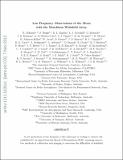| dc.contributor.author | Cappallo, Roger J. | |
| dc.contributor.author | Corey, Brian E. | |
| dc.contributor.author | Goeke, Robert F. | |
| dc.contributor.author | Hewitt, Jacqueline N. | |
| dc.contributor.author | Kincaid, Barton B. | |
| dc.contributor.author | Kratzenberg, Eric W. | |
| dc.contributor.author | Lonsdale, Colin John | |
| dc.contributor.author | McWhirter, Stephen R. | |
| dc.contributor.author | Morgan, Edward H. | |
| dc.contributor.author | Remillard, Ronald Alan | |
| dc.contributor.author | Rogers, Alan E. E. | |
| dc.contributor.author | Salah, J. E. | |
| dc.contributor.author | Whitney, Alan R. | |
| dc.contributor.author | Williams, Christopher Leigh | |
| dc.date.accessioned | 2014-07-22T12:25:58Z | |
| dc.date.available | 2014-07-22T12:25:58Z | |
| dc.date.issued | 2012-12 | |
| dc.date.submitted | 2012-07 | |
| dc.identifier.issn | 0004-6256 | |
| dc.identifier.issn | 1538-3881 | |
| dc.identifier.uri | http://hdl.handle.net/1721.1/88451 | |
| dc.description.abstract | A new generation of low-frequency radio telescopes is seeking to observe the redshifted 21 cm signal from the epoch of reionization (EoR), requiring innovative methods of calibration and imaging to overcome the difficulties of wide-field low-frequency radio interferometry. Precise calibration will be required to separate the expected small EoR signal from the strong foreground emission at the frequencies of interest between 80 and 300 MHz. The Moon may be useful as a calibration source for detection of the EoR signature, as it should have a smooth and predictable thermal spectrum across the frequency band of interest. Initial observations of the Moon with the Murchison Widefield Array 32 tile prototype show that the Moon does exhibit a similar trend to that expected for a cool thermally emitting body in the observed frequency range, but that the spectrum is corrupted by reflected radio emission from Earth. In particular, there is an abrupt increase in the observed flux density of the Moon within the internationally recognized frequency modulated (FM) radio band. The observations have implications for future low-frequency surveys and EoR detection experiments that will need to take this reflected emission from the Moon into account. The results also allow us to estimate the equivalent isotropic power emitted by the Earth in the FM band and to determine how bright the Earth might appear at meter wavelengths to an observer beyond our own solar system. | en_US |
| dc.description.sponsorship | National Science Foundation (U.S.) (Grant AST-0457585) | en_US |
| dc.description.sponsorship | National Science Foundation (U.S.) (Grant AST-0908884) | en_US |
| dc.description.sponsorship | National Science Foundation (U.S.) (Grant PHY-0835713) | en_US |
| dc.description.sponsorship | United States. Air Force Office of Scientific Research (Grant FA9550-0510247) | en_US |
| dc.description.sponsorship | Smithsonian Astrophysical Observatory | en_US |
| dc.description.sponsorship | MIT School of Science | en_US |
| dc.language.iso | en_US | |
| dc.publisher | IOP Publishing | en_US |
| dc.relation.isversionof | http://dx.doi.org/10.1088/0004-6256/145/1/23 | en_US |
| dc.rights | Creative Commons Attribution-Noncommercial-Share Alike | en_US |
| dc.rights.uri | http://creativecommons.org/licenses/by-nc-sa/4.0/ | en_US |
| dc.source | arXiv | en_US |
| dc.title | LOW-FREQUENCY OBSERVATIONS OF THE MOON WITH THE MURCHISON WIDEFIELD ARRAY | en_US |
| dc.type | Article | en_US |
| dc.identifier.citation | McKinley, B., F. Briggs, D. L. Kaplan, L. J. Greenhill, G. Bernardi, J. D. Bowman, A. de Oliveira-Costa, et al. “LOW-FREQUENCY OBSERVATIONS OF THE MOON WITH THE MURCHISON WIDEFIELD ARRAY.” The Astronomical Journal 145, no. 1 (January 1, 2013): 23. | en_US |
| dc.contributor.department | Haystack Observatory | en_US |
| dc.contributor.department | MIT Kavli Institute for Astrophysics and Space Research | en_US |
| dc.contributor.mitauthor | Cappallo, Roger J. | en_US |
| dc.contributor.mitauthor | Corey, Brian E. | en_US |
| dc.contributor.mitauthor | Goeke, Robert F. | en_US |
| dc.contributor.mitauthor | Hewitt, Jacqueline N. | en_US |
| dc.contributor.mitauthor | Kincaid, Barton B. | en_US |
| dc.contributor.mitauthor | Kratzenberg, Eric W. | en_US |
| dc.contributor.mitauthor | Lonsdale, Colin John | en_US |
| dc.contributor.mitauthor | McWhirter, Stephen R. | en_US |
| dc.contributor.mitauthor | Morgan, Edward H. | en_US |
| dc.contributor.mitauthor | Remillard, Ronald Alan | en_US |
| dc.contributor.mitauthor | Rogers, Alan E. E. | en_US |
| dc.contributor.mitauthor | Salah, J. E. | en_US |
| dc.contributor.mitauthor | Whitney, Alan R. | en_US |
| dc.contributor.mitauthor | Williams, Christopher Leigh | en_US |
| dc.relation.journal | The Astronomical Journal | en_US |
| dc.eprint.version | Author's final manuscript | en_US |
| dc.type.uri | http://purl.org/eprint/type/JournalArticle | en_US |
| eprint.status | http://purl.org/eprint/status/PeerReviewed | en_US |
| dspace.orderedauthors | McKinley, B.; Briggs, F.; Kaplan, D. L.; Greenhill, L. J.; Bernardi, G.; Bowman, J. D.; de Oliveira-Costa, A.; Tingay, S. J.; Gaensler, B. M.; Oberoi, D.; Johnston-Hollitt, M.; Arcus, W.; Barnes, D.; Bunton, J. D.; Cappallo, R. J.; Corey, B. E.; Deshpande, A.; deSouza, L.; Emrich, D.; Goeke, R.; Hazelton, B. J.; Herne, D.; Hewitt, J. N.; Kasper, J. C.; Kincaid, B. B.; Koenig, R.; Kratzenberg, E.; Lonsdale, C. J.; Lynch, M. J.; McWhirter, S. R.; Mitchell, D. A.; Morales, M. F.; Morgan, E.; Ord, S. M.; Pathikulangara, J.; Prabu, T.; Remillard, R. A.; Rogers, A. E. E.; Roshi, A.; Salah, J. E.; Sault, R. J.; Udaya Shankar, N.; Srivani, K. S.; Stevens, J.; Subrahmanyan, R.; Wayth, R. B.; Waterson, M.; Webster, R. L.; Whitney, A. R.; Williams, A.; Williams, C. L.; Wyithe, J. S. B. | en_US |
| dc.identifier.orcid | https://orcid.org/0000-0002-4117-570X | |
| dc.identifier.orcid | https://orcid.org/0000-0001-7130-208X | |
| dc.identifier.orcid | https://orcid.org/0000-0003-1941-7458 | |
| dspace.mitauthor.error | true | |
| mit.license | OPEN_ACCESS_POLICY | en_US |
| mit.metadata.status | Complete | |
